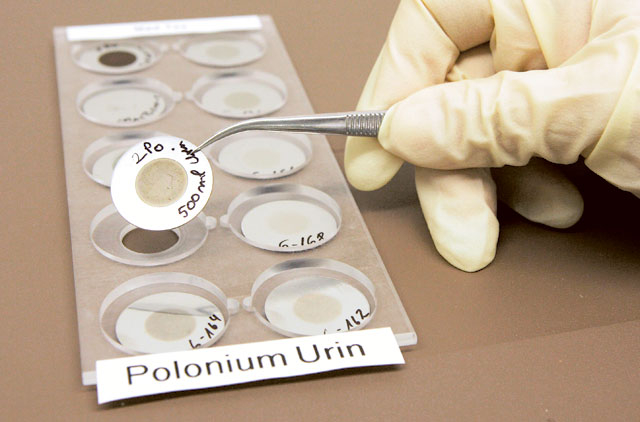
Dubai: At first they thought it must have been something he’d eaten. About two hours after having supper, at 11.30pm on the evening of October 11, 2004, Yasser Arafat felt sick.
The 75-year-old chairman of the Palestine Liberation Organisation (PLO) vomited twice, then felt a little better.
But when he awoke the next morning, he felt worse. A doctor diagnosed viral gastroenteritis, and the Palestinian leader was given medicine.
By that evening he seemed to be responding well, and a report later stated he “continued with his usual activities” at his compound in Ramallah on the West Bank.
Over the next few days Arafat’s condition stabilised, but did not improve. Medical staff were baffled, and it was only when Tunisian doctors were summoned, nearly two weeks after he fell ill, that the real cause of Arafat’s illness was diagnosed: thrombocytopenia — a reduced number of platelets in the blood.
Platelets are a key part of the clotting system, and a low count can lead to spontaneous internal bleeding.
Bone marrow samples were taken and, as he deteriorated further, Arafat was flown to the Percy Military Hospital in Paris.
On November 3, he fell into a coma, and in the early hours of November 11 he died of internal bleeding in the brain.
For nearly a decade, the true cause of death of a man regarded as the father of Palestinian resistance has remained a mystery, amid accusations from his family and supporters that he was poisoned.
This week, however, the world came a step closer to finding out the truth.
Two years ago, Arafat’s widow and daughter demanded a French judicial inquiry into his death. Since then Swiss scientists have investigated his belongings for traces of poison.
And they have announced the results in the medical journal The Lancet: they found traces of a highly toxic radioactive material, polonium-210, on his headwear, underpants and toothbrush.
In the article, coyly titled “Improving forensic investigation for polonium poisoning”, the team say they took samples of blood, sweat and urine from Arafat’s clothes and found they contained significantly higher than expected levels of polonium-210.
“These findings support the possibility of Arafat’s poisoning with polonium-210,” the report baldly states. It is a conclusion that tallies with another investigation of Arafat’s belongings, which was published in May last year.
The authors of both reports stress that their findings are not definitive, but they certainly point to an assassination.
For a start, Arafat’s symptoms were almost identical to those of a 43-year-old Russian admitted to University College Hospital, London, in November 2006, suffering from a mysterious illness. He died on November 22 that year.
That man was a former Russian intelligence agent called Alexander Litvinenko. A post-mortem examination revealed he had been poisoned by polonium-210.
Did the Palestinian leader suffer the same fate? And if so, who were the killers?
To most people the answer seems obvious — Israel, or to be specific, the Israeli Institute for Intelligence and Special Operations, better known as Mossad.
Certainly the organisation does not shy away from dirty tricks including kidnapping and assassination. Killing Arafat would have been well within its remit.
After all, Arafat conducted a campaign against Israel and its illegal occupation of Palestine for decades, and groups under his direct or indirect command were responsible for hundreds of bombing, hijackings, assassinations and other attacks.
Since it was founded in December 1949, Mossad has earned an almost mythic notoriety. One of its earliest successes was the abduction of Adolf Eichmann — the Nazi architect of the final solution — from a street in Buenos Aires in 1960.
While Eichmann was taken to Israel to face a trial and execution, other Nazi war criminals were dispatched with less due process.
In 1965, a 64-year-old Latvian called Herberts Cukurs was lured into a small house in Montevideo, Uruguay, by a portly, balding man calling himself Anton Kunzle.
As Cukurs stepped into the hall he was leapt upon by a Mossad team and killed with two bullets to the brain. His body was packed into a trunk with a note that identified his killers as “Those Who Will Never Forget”. The hit had been carried out in revenge for the murder of Jews by Cukurs in Riga during the war.
Mossad has a long memory and its revenge is brutally efficient, as witnessed in Operation Wrath of God, its response to the 1972 massacre of 11 members of the Israeli Olympic team by Palestinian resistance fighters. The operation lasted for two decades and involved a worldwide series of shootings and bombings.
All the assassinations were meticulously planned. While some were straightforward shootings, others, such as the killing of Mahmoud Hamshari, the PLO’s man in France, were more complicated.
Towards the end of 1972, a Mossad team placed a bomb under a phone on Mahmoud’s desk.
An agent pretending to be a journalist rang up. When Mahmoud answered, the Israelis detonated the bomb with an electronic signal down the phone line.
According to one account, the ultra-secret agency within the organisation that carries out assassinations is appropriately called the Kidon — bayonet.
In 1997, the Kidon was supposedly behind the botched attempt to assassinate Khaled Meshaal, the leader of Hamas.
The plan involved spraying a poison developed at Israel’s top secret Nes Tziona biological institute into the ear of the Hamas leader while he was in Jordan.
The attempt, on September 25, 1997, was a fiasco. Though agents managed to spray the poison into their target’s ear, two of them were arrested almost immediately.
The Jordanians were furious and insisted that Israel supply an antidote to save Khaled’s life.
Such failures are rare for the Kidon, though. Its most recent spectacular assassination was the killing of Mahmoud Al Mabhouh, a senior Hamas commander found dead in Dubai in January 2010.
It quickly became apparent that his death was not natural, and that it was a Mossad hit.
To the fascination of the world, authorities in Dubai released images of the faked passports of the killers, who were posing as tourists from countries including Britain, Ireland and the US.
Today, one of the riskiest jobs in the world is being an Iranian nuclear scientist. On January 11, 2011, Mostafa Ahmadi Roshan, deputy head of the Natanz uranium enrichment plant, was blown up in his car by a magnetic bomb as he drove to work. His death followed those of three other scientists in 2010.
At the beginning of this month, when Mojtaba Ahmadi, of the Islamic Revolutionary Guard Corps’ cyber warfare unit, was gunned down by black-clad gunmen on motorcycles near his home in Karaj, northwest of Tehran, Mossad was top of the list of suspects.
But the question remains:
Was Mossad responsible for Arafat’s death? Clearly, the Israelis had the ability to kill him — and they had tried before.
In 1995 the Israeli air force attacked a PLO base in Tunis, admitting it had targeted the building where Arafat had offices. Arafat survived because he was out jogging.
In 2003, the year before the PLO leader died, his security adviser Hani Al Hassan claimed that his boss had survived no fewer than 13 assassination attempts, including a package of anthrax that was sent to him in May that year.
Attempts on Arafat’s life had started in the 1960s. In December 1967 he narrowly escaped being killed at his villa in Ramallah. Hearing Israeli voices, he leapt from the second floor and hid in a parked car.
On another occasion, in Beirut, Israeli snipers were said to have had Arafat in their sights, only for the hit to be aborted on the orders of General Ariel Sharon.
So Israel has form on Arafat and, as a nuclear power, it was able to acquire polonium-210. Could one of its agents have applied a lethal dose to Arafat’s toothbrush, so it was absorbed through the gums? It sounds far-fetched — but so does spraying poison in an enemy’s ear.
—Compiled from agencies













